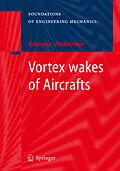The book presents methods of mathematical modeling of vortex wakes of aircraft in flights at high altitudes and close to the ground at take-off-landing regimes. The modeling is based on an extensive application of the method of discrete vortices in aircraft flights at high altitudes and on a conjugation of this method with the integral method of predicting the turbulent boundary layer which is produced at the secondary wall transversal flow induced by the aircraft vertex system at take-of-landing regimes. In this latter case an interaction between the vortex wake of aircraft and the secondary vortices generated at boundary layer separations is taken into account.
The authors consider separately methods of modeling the near and far vortex wakes of aircrafts with turbojets and air propellers and they present the results of predicting vortex wakes of a series of domestic and foreign aircrafts. The effect of number of factors is taken into account in these cases: turbulence and atmosphere stratification, presence of side wind at take- off-landing regimes.
The computer time consumption while modeling the vortex wakes according to the proposed method is 3 - 4 orders less than in the case of using the well-known numerical methods.
The non-linear non-stationary mathematical model of light aircraft movement when they enter the vortex wake of a heavy aircraft with a description of possible catastrophic consequences for the light aircraft is considered separately. A comparison between the prediction data and the experimental results is given.
The book is intended for researchers and engineers, as well as for lecturers, post-graduate and undergraduate students.
Zusammenfassung
Investigation of vortex wakes behind various aircraft, especially behind wide bodied and heavy cargo ones, is of both scientific and practical in terest. The vortex wakes shed from the wing's trailing edge are long lived and attenuate only atdistances of1012kmbehindthe wake generating aircraft. The encounter of other aircraft with the vortex wake of a heavy aircraft is open to catastrophic hazards. For example, air refueling is adangerous operationpartly due to thepossibility of the receiver aircraft's encountering the trailing wake of the tanker aircraft. It is very important to know the behavior of vortex wakes of aircraft during theirtakeoff andlanding operations whenthe wakes canpropagate over the airport's ground surface and be a serious hazard to other depart ing or arriving aircraft. This knowledge can help in enhancing safety of aircraft's movements in the terminal areas of congested airports where the threat of vortex encounters limits passenger throughput. Theoreticalinvestigations of aircraft vortex wakes arebeingintensively performedinthe major aviationnations.Usedforthispurpose are various methods for mathematical modeling of turbulent flows: direct numerical simulation based on the NavierStokes equations, large eddy simulation using the NavierStokes equations in combination with subrigid scale modeling, simulation based on the Reynolds equations closed with a differential turbulence model. These approaches are widely used in works of Russian and other countries' scientists. It should be emphasized that the experiments in wind tunnels and studies of natural vortex wakes behind heavy and light aircraft in flight experiments are equally important.
Inhalt
General.- Discrete Vortex Method.- The Near Vortex Wake Behind a Single Aircraft.- Far Vortex Wake Behind a Turbojet Aircraft.- Vortex Wakes Behind Propeller-Driven Aircraft.- Wind Flow Over Rough Terrain.- Simulation of the Far Vortex Wake of an Aircraft at Takeoff and Landing.- Aerodynamic Loads on Aircraft Encountering Vortex Wakes of Other Aircraft.
